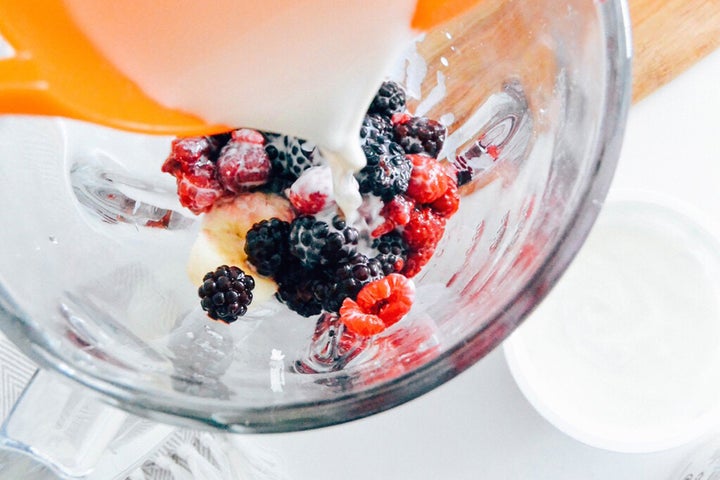
By Cathie Ericson
This post originally appeared on LearnVest as “These Frozen Foods Can Save You Money Without Skimping on Nutrition.”
Today is National Frozen Food Day, an event that might remind you of cardboard TV dinners or that prehistoric bag of peas in your fridge just waiting to provide cold comfort to a bumped head.
But we think you’ll warm up to frozen foods when you realize how many options are healthy for your bank account and your body.
The Health and Money Benefits of Eating Frozen
“In many cases frozen can be just as healthy — if not healthier — than fresh,” says Bonnie Taub-Dix, RDN, creator of BetterThanDieting.com. “Frozen produce is picked fresh at peak nutritional value and then travels frozen to the store, to your freezer and finally your table. Provided the frozen foods are handled properly, they can retain nutrients that otherwise might diminish during transit.”
Contrast that with fresh foods, which are often shipped long distances while exposed to light and heat, sapping their nutritional power. Once they arrive at the store, they might score long stretches of shelf time until finally finding a home in your fridge.
Of course, not all frozen foods are health superstars, particularly prepackaged meals (think breakfast burritos and dinner entrees). To avoid the nutritional offenders, Taub-Dix advises reading ingredient labels and skipping products with excess sugar and sodium, based on USDA recommendations.
As for the money-saving benefits, frozen foods can be 50% cheaper than their fresh counterparts, if not more. And since they can be stored for weeks or even months without spoiling, you cut down on waste and the cost of having to toss fresh items that have gone bad before you had the chance to consume them.
The Best Frozen Foods to Have on Hand
These staples are tasty, good for you and super convenient to keep in your fridge for those times when you need to whip up a meal fast.
Berries: A bag of frozen berries runs half the cost of the fresh kind, yet pack the same high levels of fiber and antioxidants, says Taub-Dix. They lose some of their texture and aesthetic appeal when thawed, so skip them as a garnish and instead toss into smoothies, cereal or yogurt, or bake them in muffins.
Mangos: While frozen mango is a bargain at less than half the cost of fresh, assume you’re saving even more since time is money — and mangos can be a bear to prepare. They’re an all-star snack though: one cup provides 100% and 35% respectively of your daily Vitamin C and A needs, plus 20 other vitamins and minerals.
Spinach: Expect to pay roughly half as much for frozen spinach versus fresh. Bonus if you also save time buying the pre-chopped kind. This green leafy veggie is a low-calorie delivery system for fiber, potassium, iron and Vitamins A and C.
Fish fillets: Good luck finding truly fresh flounder, tuna or others at most supermarkets. Since fish spoils easily, the varieties sold on ice at the fish counter is often “fresh from frozen." Instead, head to the freezer case. The fillets and seafood here sell for a quarter of the price of the counter kind and are less likely to be contaminated by bacteria. Yet they're loaded with the same omega-3s and vitamins A and D.
Salmon burgers: Salmon burgers make a delicious quickie dinner and run you a fraction of the cost of fresh salmon. Taub-Dix recommends checking the package for less-healthy additives. “If you see bread crumbs first, then rice, egg or other fillers before the salmon, you’ll want to look for another brand,” she says.
Frozen meals: You wouldn't want to live on them, but many entrees are a solid go-to if you would otherwise be ordering pizza after work or noshing a giant sub at your desk. And they're definitely cheaper than if you bought all the ingredients separately or picked up the take-out version made fresh in a restaurant.
“Frozen dinners are getting healthier — nothing like the old-school TV dinners with the salty mashed potatoes and a brownie,” says Taub-Dix. Go for options that contain healthy ingredients, like brown rice, lean protein and veggies. Don't forget to give the sodium content the once-over so you know you're not exceeding the recommended daily amount (about 2,300 milligrams), she suggests.
More From LearnVest
LearnVest is a simple plan for your money. Read our helpful personal finance articles, use our budgeting tools and talk with one of our financial planners to help start making progress toward your financial goals.
LearnVest Planning Services is a registered investment adviser and subsidiary of LearnVest, Inc. that provides financial plans for its clients. Information shown is for illustrative purposes only and is not intended as investment advice. Please consult a financial adviser for advice specific to your financial situation. LearnVest Planning Services and any third-parties listed, discussed, identified or otherwise appearing herein are separate and unaffiliated and are not responsible for each other’s products, services or policies. LearnVest, Inc. is wholly owned by NM Planning, LLC, a subsidiary of The Northwestern Mutual Life Insurance Company.
